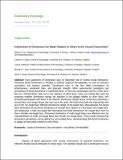Files in this item
Impressions of dominance are made relative to others in the visual environment
Item metadata
| dc.contributor.author | Re, Daniel E. | |
| dc.contributor.author | Lefevre, Carmen E. | |
| dc.contributor.author | DeBruine, Lisa M. | |
| dc.contributor.author | Jones, Benedict C. | |
| dc.contributor.author | Perrett, David I. | |
| dc.date.accessioned | 2014-11-20T17:01:20Z | |
| dc.date.available | 2014-11-20T17:01:20Z | |
| dc.date.issued | 2014 | |
| dc.identifier | 157939063 | |
| dc.identifier | 20f291e8-2e4e-416d-a73f-4b477fc04171 | |
| dc.identifier | 000343695600017 | |
| dc.identifier | 84920287002 | |
| dc.identifier.citation | Re , D E , Lefevre , C E , DeBruine , L M , Jones , B C & Perrett , D I 2014 , ' Impressions of dominance are made relative to others in the visual environment ' , Evolutionary Psychology , vol. 12 , no. 1 , pp. 251-263 . | en |
| dc.identifier.issn | 1474-7049 | |
| dc.identifier.other | ORCID: /0000-0002-6025-0939/work/64360954 | |
| dc.identifier.uri | https://hdl.handle.net/10023/5825 | |
| dc.description.abstract | Face judgments of dominance play an important role in human social interaction. Perceived facial dominance is thought to indicate physical formidability, as well as resource acquisition and holding potential. Dominance cues in the face affect perceptions of attractiveness, emotional state, and physical strength. Most experimental paradigms test perceptions of facial dominance in individual faces, or they use manipulated versions of the same face in a forced-choice task but in the absence of other faces. Here, we extend this work by assessing whether dominance ratings are absolute or are judged relative to other faces. We presented participants with faces to be rated for dominance (target faces), while also presenting a second face (non-target faces) that was not to be rated. We found that both the masculinity and sex of the non-target face affected dominance ratings of the target face. Masculinized non-target faces decreased the perceived dominance of a target face relative to a feminized non-target face, and displaying a male non-target face decreased perceived dominance of a target face more so than a female non-target face. Perceived dominance of male target faces was affected more by masculinization of male non-target faces than female non-target faces. These results indicate that dominance perceptions can be altered by surrounding faces, demonstrating that facial dominance is judged at least partly relative to other faces. | |
| dc.format.extent | 13 | |
| dc.format.extent | 355537 | |
| dc.language.iso | eng | |
| dc.relation.ispartof | Evolutionary Psychology | en |
| dc.subject | physical dominance | en |
| dc.subject | face perception | en |
| dc.subject | masculinity | en |
| dc.subject | formidability | en |
| dc.subject | Sexual-dimorphism | en |
| dc.subject | Personality dimensions | en |
| dc.subject | Facial attractiveness | en |
| dc.subject | Aggresive-behavior | en |
| dc.subject | Adolescent males | en |
| dc.subject | Testosterone | en |
| dc.subject | Face | en |
| dc.subject | Appearance | en |
| dc.subject | Perception | en |
| dc.subject | Evolution | en |
| dc.subject | BF Psychology | en |
| dc.subject.lcc | BF | en |
| dc.title | Impressions of dominance are made relative to others in the visual environment | en |
| dc.type | Journal article | en |
| dc.contributor.institution | University of St Andrews. School of Psychology and Neuroscience | en |
| dc.contributor.institution | University of St Andrews. Institute of Behavioural and Neural Sciences | en |
| dc.contributor.institution | University of St Andrews. Centre for Social Learning & Cognitive Evolution | en |
| dc.description.status | Peer reviewed | en |
| dc.identifier.url | http://epjournal.net/3219 | en |
This item appears in the following Collection(s)
Items in the St Andrews Research Repository are protected by copyright, with all rights reserved, unless otherwise indicated.

